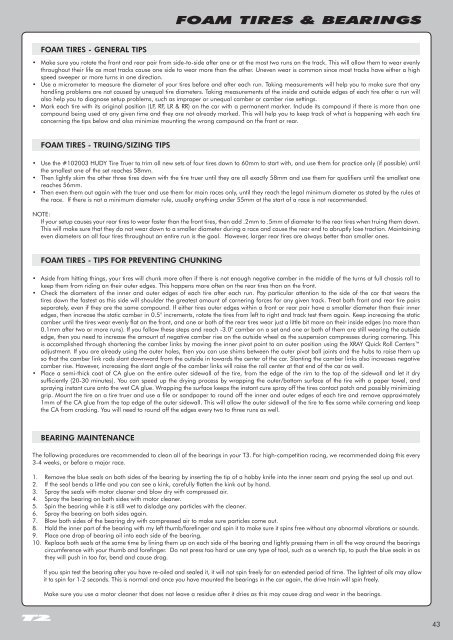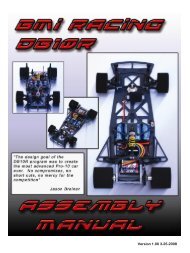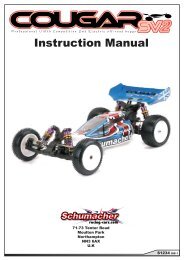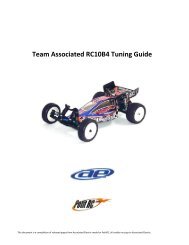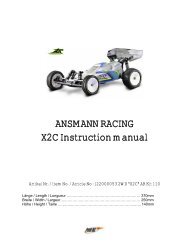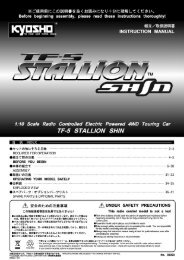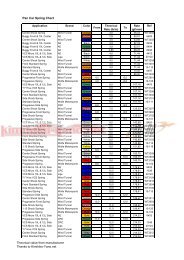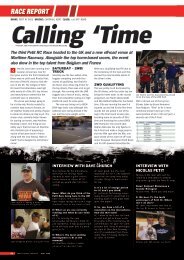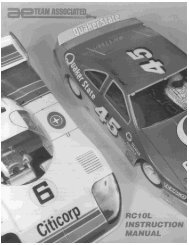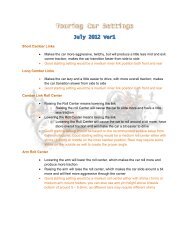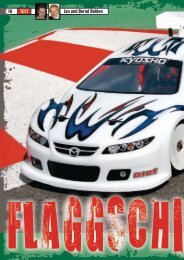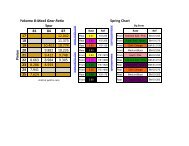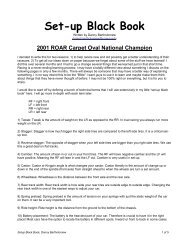XRAY T3 Set-up Book - Petit RC
XRAY T3 Set-up Book - Petit RC
XRAY T3 Set-up Book - Petit RC
You also want an ePaper? Increase the reach of your titles
YUMPU automatically turns print PDFs into web optimized ePapers that Google loves.
FOAM TIRES & BEARINGS<br />
foam tires - GENERAL TIPS<br />
• Make sure you rotate the front and rear pair from side-to-side after one or at the most two runs on the track. This will allow them to wear evenly<br />
throughout their life as most tracks cause one side to wear more than the other. Uneven wear is common since most tracks have either a high<br />
speed sweeper or more turns in one direction.<br />
• Use a micrometer to measure the diameter of your tires before and after each run. Taking measurements will help you to make sure that any<br />
handling problems are not caused by unequal tire diameters. Taking measurements of the inside and outside edges of each tire after a run will<br />
also help you to diagnose set<strong>up</strong> problems, such as improper or unequal camber or camber rise settings.<br />
• Mark each tire with its original position (LF, RF, LR & RR) on the car with a permanent marker. Include its compound if there is more than one<br />
compound being used at any given time and they are not already marked. This will help you to keep track of what is happening with each tire<br />
concerning the tips below and also minimize mounting the wrong compound on the front or rear.<br />
FOAM TIRES - TRUING/SIZING TIPS<br />
• Use the #102003 HUDY Tire Truer to trim all new sets of four tires down to 60mm to start with, and use them for practice only (if possible) until<br />
the smallest one of the set reaches 58mm.<br />
• Then lightly skim the other three tires down with the tire truer until they are all exactly 58mm and use them for qualifiers until the smallest one<br />
reaches 56mm.<br />
• Then even them out again with the truer and use them for main races only, until they reach the legal minimum diameter as stated by the rules at<br />
the race. If there is not a minimum diameter rule, usually anything under 55mm at the start of a race is not recommended.<br />
NOTE:<br />
If your set<strong>up</strong> causes your rear tires to wear faster than the front tires, then add .2mm to .5mm of diameter to the rear tires when truing them down.<br />
This will make sure that they do not wear down to a smaller diameter during a race and cause the rear end to abr<strong>up</strong>tly lose traction. Maintaining<br />
even diameters on all four tires throughout an entire run is the goal. However, larger rear tires are always better than smaller ones.<br />
FOAM TIRES - TIPS FOR PREVENTING CHUNKING<br />
• Aside from hitting things, your tires will chunk more often if there is not enough negative camber in the middle of the turns at full chassis roll to<br />
keep them from riding on their outer edges. This happens more often on the rear tires than on the front.<br />
• Check the diameters of the inner and outer edges of each tire after each run. Pay particular attention to the side of the car that wears the<br />
tires down the fastest as this side will shoulder the greatest amount of cornering forces for any given track. Treat both front and rear tire pairs<br />
separately, even if they are the same compound. If either tires outer edges within a front or rear pair have a smaller diameter than their inner<br />
edges, then increase the static camber in 0.5° increments, rotate the tires from left to right and track test them again. Keep increasing the static<br />
camber until the tires wear evenly flat on the front, and one or both of the rear tires wear just a little bit more on their inside edges (no more than<br />
0.1mm after two or more runs). If you follow these steps and reach -3.0° camber on a set and one or both of them are still wearing the outside<br />
edge, then you need to increase the amount of negative camber rise on the outside wheel as the suspension compresses during cornering. This<br />
is accomplished through shortening the camber links by moving the inner pivot point to an outer position using the <strong>XRAY</strong> Quick Roll Centers<br />
adjustment. If you are already using the outer holes, then you can use shims between the outer pivot ball joints and the hubs to raise them <strong>up</strong><br />
so that the camber link rods slant downward from the outside in towards the center of the car. Slanting the camber links also increases negative<br />
camber rise. However, increasing the slant angle of the camber links will raise the roll center at that end of the car as well.<br />
• Place a semi-thick coat of CA glue on the entire outer sidewall of the tire, from the edge of the rim to the top of the sidewall and let it dry<br />
sufficiently (20-30 minutes). You can speed <strong>up</strong> the drying process by wrapping the outer/bottom surface of the tire with a paper towel, and<br />
spraying instant cure onto the wet CA glue. Wrapping the surface keeps the instant cure spray off the tires contact patch and possibly minimizing<br />
grip. Mount the tire on a tire truer and use a file or sandpaper to round off the inner and outer edges of each tire and remove approximately<br />
1mm of the CA glue from the top edge of the outer sidewall. This will allow the outer sidewall of the tire to flex some while cornering and keep<br />
the CA from cracking. You will need to round off the edges every two to three runs as well.<br />
BEARING MAINTENANCE<br />
The following procedures are recommended to clean all of the bearings in your <strong>T3</strong>. For high-competition racing, we recommended doing this every<br />
3-4 weeks, or before a major race.<br />
1. Remove the blue seals on both sides of the bearing by inserting the tip of a hobby knife into the inner seam and prying the seal <strong>up</strong> and out.<br />
2. If the seal bends a little and you can see a kink, carefully flatten the kink out by hand.<br />
3. Spray the seals with motor cleaner and blow dry with compressed air.<br />
4. Spray the bearing on both sides with motor cleaner.<br />
5. Spin the bearing while it is still wet to dislodge any particles with the cleaner.<br />
6. Spray the bearing on both sides again.<br />
7. Blow both sides of the bearing dry with compressed air to make sure particles come out.<br />
8. Hold the inner part of the bearing with my left thumb/forefinger and spin it to make sure it spins free without any abnormal vibrations or sounds.<br />
9. Place one drop of bearing oil into each side of the bearing.<br />
10. Replace both seals at the same time by lining them <strong>up</strong> on each side of the bearing and lightly pressing them in all the way around the bearings<br />
circumference with your thumb and forefinger. Do not press too hard or use any type of tool, such as a wrench tip, to push the blue seals in as<br />
they will push in too far, bend and cause drag.<br />
If you spin test the bearing after you have re-oiled and sealed it, it will not spin freely for an extended period of time. The lightest of oils may allow<br />
it to spin for 1-2 seconds. This is normal and once you have mounted the bearings in the car again, the drive train will spin freely.<br />
Make sure you use a motor cleaner that does not leave a residue after it dries as this may cause drag and wear in the bearings.<br />
43


